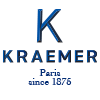EXCEPTIONAL FURNITURE
Splendid “à la tronchin” architect table,
presented by Olivier Kraemer
This table is a prime example of the craftsmanship of Roentgen, a cabinetmaker. Only few of them exist today. Tables such as this one are known as “Tronchin”; they were invented by doctor Theodor Tronchin during the reign of Louis XVI. Tronchin was born and raised in Geneva; he tended to architects who suffered from back pain from bending over while working. He invented this model to ease their pain.
David Roentgen (1743-1807) was a cabinetmaker and an inlayer from German descent who worked for the 18th century French court. He collaborated with the famous clockmaker Pierre Kinzing, who helped him specialise in mechanised furniture. He worked for the likes of Marie-Antoinette and Catherine II of Russia, as well as other well-known aristocrats. Roentgen was very productive; he was influenced by many European art movements. His marquetry furniture and his impressive works of art, which rely on mahogany veneer, made him famous.
This mahogany veneer “tronchin” table dates back to the end of the 18th century. The table’s height can be adjusted thanks to its various notches. It can be used as a secretary and includes a sliding case where one could file documents. There is also a book on the little ruler.
The book in question shows a table that is very similar to the one that can be found at the Nissim de Camondo museum, located at 63 rue de Monceau. It contains an excerpt from the “Journal des Luxus und der Modern” which was published in Weimar in 1795. In the book, Roentgen described the various techniques he would use in his craft. 18th century craftsmen developed a keen interest in mechanical furniture pieces and set a trend for such objects.
There are forty tables of this kind. Only ten of them have been located so far; some of them can be found at the Pavlovsk Palace and at the State Ermitage Museum. Another one, which is very similar to this model, is featured in the Duke of Devonshire’s personal collection, at Chatsworth Castle. The New York Metropolitan Museum of Art owns yet another one.
Jean Holthausen is a Parisian cabinetmaker from German descent. He obtained his degree in 1764. He worked during the Regency, during Louis XV’s reign, and during the Transition period. Since he got his degree later in life, few of his pieces of furniture were stamped. His works of art denote a keen interest in maquetry details, such as flowers and cubes. His love of lacquer from the Far East, which he used on plated and veneer pieces, makes him stand out.
Coromandel lacquers were invented in China in the early 17th century. The English named them this because they used to load East India Company ships with lacquers along the East Indian coast. Thin layers of wood were covered with fabric and placed on top of each other. They were held together with vegetable glue. The resulting lacquer was painted and decorated with carved patterns.
These lacquers used to adorn large cabinets and screens. European craftsmen would dismantle them and add the lacquers to fashionable pieces of furniture. Lacquered panels were used to decorate chests of drawers, corner pieces and other pieces of furniture.
This Coromandel lacquered chest of drawers shows how much European countries used to like Oriental aesthetics. This was the case in France, which was deeply influenced by haberdashers since the beginning of Louis XV’s reign in 1730. Artists would extract lacquer from imported pieces of furniture. They would then refine them and transfer them onto their own furniture pieces. Once they had added them to the new piece, they crafted delicate gilded bronze settings for them.
This chest of drawers is a beautiful example of Holthausen’s style, which is a reflection of its time: the craftsman added lacquer to a black piece of furniture in order to create a harmonious piece that remained faithful to the panel’s former aesthetics.
The slightly rounded exterior highlights the characters that were painted on the lacquered panels. Delicate bronze-coloured ornaments can be found on the lines, on the locks and on the handles. Their Louis XV-inspired curves and counter-curves emphasise the delicate lines on the chest of drawers. The black-veined marble top adds a final touch to the piece and its delicate mouldings complement the artwork’s shape.
In Holthausen’s work, lacquered pieces of furniture are rare: this chest of drawers is a unique work of art.
Ébéniste parisien d’origine allemande, Jean Holthausen obtient sa maîtrise en 1764.
Son œuvre couvre les mouvements Régence, Louis XV et Transition, mais ayant obtenu sa maîtrise tardivement, peu de ses meubles sont estampillés. Ses réalisations révèlent une préférence pour les marqueteries de fleurs, de cube, d’attributs et il se démarque par un attrait pour les laques d’Extrême-Orient sous forme de placage.
Les laques dits « de Coromandel » ont été mis au point à partir du XVIIè siècle en Chine. Elles ont été nommées ainsi par les Anglais, en référence à la côté orientale de l’Inde où étaient chargées les laques sur les navires de la Compagnie des Indes. La technique du laque est la superposition de fines couches de bois recouvertes de tissu maintenues entre elles par de la colle végétale. Le laque obtenu était ensuite peint et décoré de motifs par de profondes incisions.
Ces laques décoraient à l’origine des cabinets et des paravents de grande taille qui étaient ensuite démontés par les artisans européens afin de les appliquer sur les meubles à la mode. C’est ainsi que des panneaux de laque se sont retrouvés sur les commodes, encoignures et autres meubles.
Cette commode en laque de Coromandel reflète le goût pour l’Orient des pays occidentaux et particulièrement de la France dès 1730 à partir du règne de Louis XV, sous l’influence des marchands-merciers. Ils prélevaient le laque sur les meubles importés qu’ils affinaient ensuite pour les plaquer sur le bâti de leur meuble. Une fois intégrés au meuble, ces laques recevaient des montures en bronze doré finement ciselées.
A travers cette commode, Holthausen réalise un magnifique exemple de la pratique de son temps où l’artisan décide d’apposer le laque sur un meuble de couleur noire afin de créer un ensemble harmonieux et respectueux de l’esthétique originelle du panneau.
La forme légèrement bombée de la façade donne vie aux personnages dépeints sur les panneaux de laque. Les bronzes se retrouvent discrètement en chutes, en lignes de chute, en sabots, en entrées de serrure et en poignées. Ils viennent définir et rehausser les lignes très délicates de la commode par leurs jeux de courbes et contre-courbes dignes du style Louis XV. Le dessus de marbre noir veiné vient sommer l’ensemble et souligner le galbe du meuble par sa mouluration délicate.
Les meubles ornés de laque sont rares dans l’œuvre de Holthausen, ce qui fait de cette commode un modèle unique en son genre.

